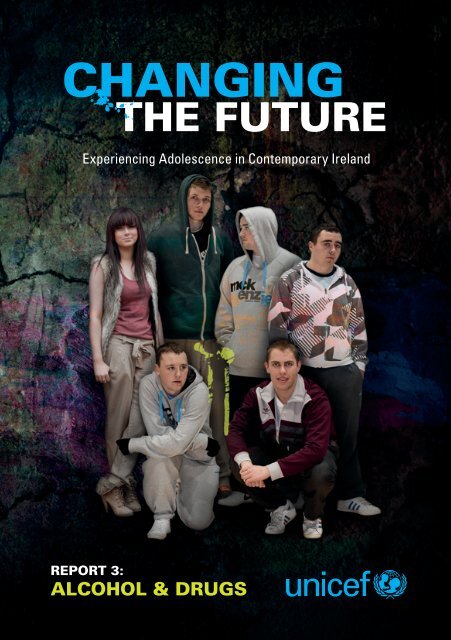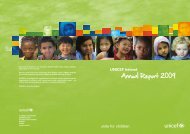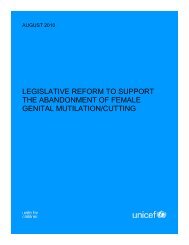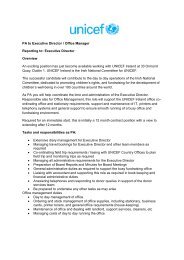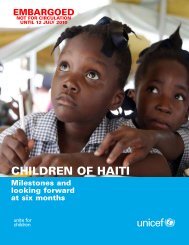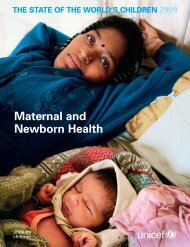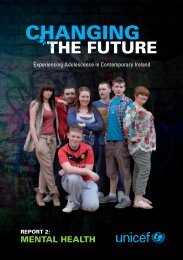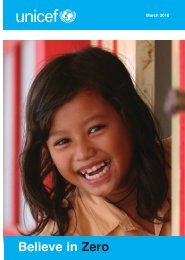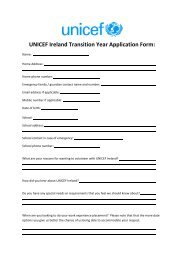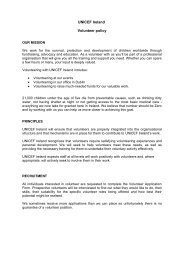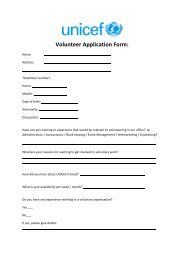Changing the future report 3 - UNICEF Ireland
Changing the future report 3 - UNICEF Ireland
Changing the future report 3 - UNICEF Ireland
Create successful ePaper yourself
Turn your PDF publications into a flip-book with our unique Google optimized e-Paper software.
CHANGING<br />
THE FUTURE<br />
Experiencing Adolescence in Contemporary <strong>Ireland</strong><br />
REPORT 3:<br />
ALCOHOL & DRUGS<br />
<strong>UNICEF</strong> <strong>Changing</strong> <strong>the</strong> Future<br />
1.
This third <strong>report</strong> in <strong>UNICEF</strong> <strong>Ireland</strong>s’ <strong>Changing</strong> <strong>the</strong> Future<br />
series addresses <strong>the</strong> very pertinent <strong>the</strong>mes of drugs<br />
and alcohol, <strong>the</strong> different levels of consumption that <strong>the</strong><br />
young respondents to <strong>UNICEF</strong> <strong>Ireland</strong>’s survey <strong>report</strong> and,<br />
most critically, <strong>the</strong> roles that drugs and alcohol seem to<br />
be playing in <strong>the</strong> lives of young Irish people today.<br />
Throughout <strong>the</strong> <strong>Changing</strong> <strong>the</strong> Future <strong>report</strong> series, <strong>UNICEF</strong><br />
has presented both <strong>the</strong> quantitative results of <strong>the</strong> survey<br />
itself, but also <strong>the</strong> qualitative responses of <strong>the</strong> young<br />
respondents to <strong>the</strong> various issues that have been raised<br />
by <strong>the</strong> survey.<br />
As is evident throughout this third <strong>report</strong> <strong>Changing</strong> <strong>the</strong><br />
Future: Experiencing Adolescence in Contemporary<br />
<strong>Ireland</strong>: Alcohol and Drugs, it is very apparent that drugs<br />
and alcohol play very influential roles in <strong>the</strong> manner<br />
in which most young Irish people navigate through<br />
adolescence.<br />
This <strong>report</strong> should leave <strong>the</strong> reader in no doubt as to how<br />
widespread drug and alcohol consumption can become<br />
among young Irish people, and how central a role <strong>the</strong>se<br />
substances can come to play in young peoples’ lives.<br />
In <strong>the</strong> words of one respondent to this survey when asked<br />
to describe <strong>the</strong>ir first drug use –<br />
“I fitted in.”<br />
The picture that <strong>the</strong> respondents paint is one in which<br />
<strong>the</strong> use of drugs and alcohol during adolescence can<br />
be understood better as <strong>the</strong> norm – ra<strong>the</strong>r than <strong>the</strong><br />
exception, and that <strong>the</strong> majority of respondents <strong>report</strong><br />
<strong>the</strong> use of substances like alcohol as something first<br />
undertaken during adolescence, ra<strong>the</strong>r than in adulthood.<br />
Drugs and Alcohol can assume very harmful roles in<br />
young peoples’ lives – both can be highly addictive and<br />
both can be highly destructive. The prevalence of drug<br />
and alcohol use <strong>report</strong>ed by <strong>the</strong> participants to this<br />
survey illustrate <strong>the</strong> point that for <strong>Ireland</strong> to successfully<br />
promote and defend young peoples’ right to <strong>the</strong> highest<br />
attainable standard of health, <strong>the</strong> normative relationship<br />
which it seems young Irish people share with <strong>the</strong>se<br />
substances, must be challenged.<br />
That is a challenge which cannot rest with any one<br />
stakeholder or individual, but ra<strong>the</strong>r must be assumed by<br />
us all. This <strong>report</strong> suggests <strong>the</strong> emergence of a dangerous<br />
orthodoxy in which drugs and alcohol are accepted as a<br />
normal part of adolescence in <strong>Ireland</strong>.<br />
If that is <strong>the</strong> case, <strong>the</strong>n we all must do more to ensure <strong>the</strong><br />
protection of young people who are exposed to <strong>the</strong>se<br />
substances, to impart appropriate and timely information<br />
upon <strong>the</strong> risks and, crucially, to provide alternatives to<br />
which young people can relate. Young people need to<br />
be able to make informed decisions about <strong>the</strong> potential<br />
implications of <strong>the</strong> habits and experiences to which <strong>the</strong>y<br />
are being exposed every day.<br />
If <strong>Ireland</strong> is to achieve <strong>the</strong> objective of developing<br />
a comprehensive framework, <strong>the</strong>n young people<br />
<strong>the</strong>mselves must be given a place at centre stage and<br />
<strong>the</strong>ir opinions must be afforded due weight.<br />
<strong>UNICEF</strong> <strong>Ireland</strong><br />
<strong>UNICEF</strong> <strong>Changing</strong> <strong>the</strong> Future<br />
3.
Drugs and Alcohol<br />
Why now?<br />
The <strong>Changing</strong> <strong>the</strong> Future <strong>report</strong> series was initiated with<br />
<strong>the</strong> clear purpose of giving young people in <strong>Ireland</strong> <strong>the</strong><br />
opportunity to identify and explore <strong>the</strong> social issues that<br />
<strong>the</strong>y identify as most significant in <strong>the</strong>ir own lives.<br />
The prevalence of alcohol and drug consumption that <strong>the</strong><br />
respondents to <strong>UNICEF</strong>’s survey have <strong>report</strong>ed suggests<br />
that those <strong>the</strong>mes pervade throughout adolescence in<br />
<strong>Ireland</strong> and, as such, have to be given precedence in a<br />
comprehensive exploration of that experience.<br />
There was a unanimity of understanding and purpose<br />
achieved in <strong>the</strong> drafting of <strong>the</strong> United Nations Convention<br />
on <strong>the</strong> Rights of <strong>the</strong> Child when it recognised in Article 33<br />
<strong>the</strong> very specific risks to young people associated with<br />
drugs abuse –<br />
“(State Parties)… shall take all appropriate<br />
measures, including legislative, administrative,<br />
social and educational measures, to protect<br />
children from <strong>the</strong> illicit use of narcotic drugs<br />
and psychotropic substances as defined in<br />
<strong>the</strong> relevant international treaties…”<br />
As noted in <strong>the</strong> National Drugs Strategy (interim) 2009<br />
– 2016, <strong>the</strong> Irish Government has given approval for <strong>the</strong><br />
development of a combined National Substance Misuse<br />
Strategy to address <strong>the</strong> misuse of both alcohol and drugs.<br />
<strong>UNICEF</strong> <strong>Ireland</strong> welcomes this decision and agrees that<br />
<strong>the</strong> policy framework governing drug and alcohol misuse<br />
in <strong>Ireland</strong> should come toge<strong>the</strong>r under <strong>the</strong> same scope.<br />
The argument for <strong>the</strong> inclusion of alcohol into a combined<br />
national substance misuse strategy is compelling and has<br />
been made consistently. Alcohol is an intoxicant that has<br />
been identified by <strong>the</strong> World Health Organisation as <strong>the</strong><br />
world’s third leading cause of ill health and premature<br />
death. It is important to consider <strong>the</strong> links between<br />
alcohol consumption and o<strong>the</strong>r high-risk behaviours to<br />
which young people in <strong>Ireland</strong> are exposed.<br />
The misuse of alcohol can and often does lead to a<br />
variety of challenges for young people – physical, mental,<br />
behavioural and social – and <strong>UNICEF</strong> <strong>Ireland</strong> believes that<br />
this is particularly true in <strong>the</strong> case of adolescents and<br />
young people.<br />
If <strong>the</strong> findings outlined in this <strong>report</strong> reflect wider trends<br />
in alcohol and drugs use amongst adolescents in <strong>Ireland</strong><br />
<strong>the</strong>n <strong>the</strong> need to include young people <strong>the</strong>mselves in<br />
discussions that will form <strong>the</strong> basis of a stronger, more<br />
cohesive and more effective national policy on drugs and<br />
alcohol becomes self-evident. The role that alcohol and<br />
drug consumption have come to play in <strong>the</strong> lives of young<br />
people in <strong>Ireland</strong> cannot be fully documented, understood<br />
or responded to unless young people <strong>the</strong>mselves are<br />
given <strong>the</strong> opportunity to relate to policy-makers <strong>the</strong>ir own<br />
experiences and perspectives.<br />
The rights of children and young people to both form<br />
and express an opinion on <strong>the</strong> matters that affect <strong>the</strong>m<br />
are enshrined as core principles of <strong>the</strong> United Nations<br />
Convention on <strong>the</strong> Rights of <strong>the</strong> Child. At this critical<br />
point in <strong>the</strong> formulation of <strong>Ireland</strong>’s policy response to <strong>the</strong><br />
challenges presented by alcohol and drug consumption<br />
amongst young people <strong>UNICEF</strong> <strong>Ireland</strong> strongly argues<br />
that young people must be given <strong>the</strong> opportunity to fulfil<br />
those rights, to have <strong>the</strong>ir voice heard and to imprint <strong>the</strong>ir<br />
perspectives upon those policies.<br />
If <strong>Ireland</strong> is to create a policy environment which is better<br />
equipped to protect and promote <strong>the</strong> health of its young<br />
citizens; <strong>the</strong>n those young citizens <strong>the</strong>mselves must be<br />
given <strong>the</strong> opportunity to participate.<br />
The discussions that will come to define <strong>Ireland</strong>’s policy<br />
response to <strong>the</strong> challenges presented by alcohol and drug<br />
consumption are already taking place. Failure to include<br />
young people in <strong>the</strong>se discussions, as much as any o<strong>the</strong>r<br />
that relates to <strong>the</strong>ir lives may come at a high cost indeed<br />
to <strong>the</strong> many young people in <strong>Ireland</strong> to whom alcohol<br />
and drugs present serious, complicated and persistent<br />
challenges.<br />
How did we do it?<br />
<strong>Changing</strong> <strong>the</strong> Future: Experiencing Adolescence in<br />
Contemporary <strong>Ireland</strong>: Drugs and Alcohol is <strong>the</strong> third in<br />
a series of four <strong>report</strong>s that will be published by <strong>UNICEF</strong><br />
<strong>Ireland</strong> in 2011. The purpose of this series is to present <strong>the</strong><br />
results of primary research that we carried out at <strong>the</strong> end<br />
of 2010, and to combine <strong>the</strong> findings of those four <strong>report</strong>s<br />
into a single holistic snapshot of adolescent wellbeing in<br />
<strong>Ireland</strong>.<br />
The first of <strong>the</strong>se four <strong>report</strong>s – <strong>Changing</strong> <strong>the</strong> Future:<br />
Experiencing Adolescence in Contemporary <strong>Ireland</strong>:<br />
Happiness, published in April 2011, has already outlined<br />
<strong>the</strong> methodology employed in this research in some<br />
detail. For that reason, <strong>Changing</strong> <strong>the</strong> Future: Experiencing<br />
Adolescence in Contemporary <strong>Ireland</strong>: Drugs and<br />
Alcohol will only restate <strong>the</strong> broadest elements of that<br />
methodology:<br />
➦➦The research includes respondents from all<br />
four Provinces – Leinster, Munster, Ulster and<br />
Connaught;<br />
➦➦The results include male and female respondents;<br />
➦➦The research featured <strong>the</strong> responses of young<br />
people aged 16 to 20 years;<br />
➦➦The survey used youth-friendly language;<br />
➦➦All information ga<strong>the</strong>red on <strong>the</strong> pages of <strong>the</strong> survey<br />
website remains confidential;<br />
➦➦No information ga<strong>the</strong>red will be shared with any<br />
o<strong>the</strong>r party;<br />
➦➦No IP addresses or o<strong>the</strong>r technical information<br />
was captured by our software or within <strong>the</strong><br />
research;<br />
➦➦No contact information that could identify any<br />
respondent for this survey - including emails,<br />
phone numbers, pictures, videos, sound files or<br />
names and addresses or o<strong>the</strong>r information was<br />
ga<strong>the</strong>red by this research;<br />
➦➦The only demographic information ga<strong>the</strong>red<br />
was: age, sex and county of residence. This is<br />
not considered sufficient to identify <strong>the</strong> location<br />
or identity of any respondent and ensures that<br />
respondents can give full and frank replies to<br />
questions without any worry of being identified at a<br />
later date by any individual, group or body;<br />
➦➦Questions were both prompted and unprompted,<br />
allowing for both qualitative and quantitative<br />
results to emerge from <strong>the</strong> data collected;<br />
➦➦The survey asked <strong>the</strong> participants to tell us ‘in <strong>the</strong>ir<br />
own words’ as often as possible;<br />
➦➦Throughout this Report, we have presented those<br />
responses exactly as <strong>the</strong>y were told to us by <strong>the</strong><br />
young people <strong>the</strong>mselves.<br />
Fur<strong>the</strong>r details of <strong>the</strong> conceptual framework and<br />
methodology employed in this research project can be<br />
gained from <strong>the</strong> series’ first <strong>report</strong> <strong>Changing</strong> <strong>the</strong> Future:<br />
Experiencing Adolescence in Contemporary <strong>Ireland</strong>:<br />
Happiness, or by contacting <strong>the</strong> offices of <strong>UNICEF</strong> <strong>Ireland</strong>.<br />
<strong>UNICEF</strong> <strong>Ireland</strong> will go on to complete <strong>the</strong> <strong>Changing</strong><br />
<strong>the</strong> Future <strong>report</strong> series with <strong>the</strong> fourth and final <strong>report</strong><br />
- <strong>Changing</strong> <strong>the</strong> Future: Experiencing Adolescence in<br />
Contemporary <strong>Ireland</strong>: Sexual Health and Behaviour later<br />
in 2011.<br />
<strong>Changing</strong> <strong>the</strong> Future: Experiencing Adolescence in Contemporary <strong>Ireland</strong>: Alcohol and Drugs. <strong>UNICEF</strong> <strong>Changing</strong> <strong>the</strong> Future 5.
prevalence of Alcohol<br />
What did we f ind?<br />
This <strong>report</strong> presents <strong>the</strong> findings of a research survey<br />
conducted by <strong>UNICEF</strong> <strong>Ireland</strong> in late 2010.<br />
The participants were asked to answer questions on a<br />
wide variety of subjects and to comment upon a variety<br />
of experiences and perspectives including those related<br />
to drugs and alcohol. In responding to this survey and<br />
answering <strong>the</strong>se questions <strong>the</strong> respondents have given<br />
us an honest and forthright account of <strong>the</strong> roles <strong>the</strong>se<br />
substances can come to play in <strong>the</strong>ir lives.<br />
<strong>Changing</strong> <strong>the</strong> Future offered all respondents <strong>the</strong><br />
opportunity to relate <strong>the</strong>ir experiences and opinions in<br />
<strong>the</strong>ir own words and in so doing to describe to us in vivid<br />
detail <strong>the</strong>ir views on drug and alcohol consumption.<br />
In presenting <strong>the</strong> findings of its’ research, <strong>UNICEF</strong> <strong>Ireland</strong><br />
asks readers to pay specific attention to <strong>the</strong> quotes of <strong>the</strong><br />
young respondents <strong>the</strong>mselves, and to reflect upon <strong>the</strong><br />
way in which those statements reflect on Irish society<br />
and its’ attitude towards drugs and alcohol as a whole.<br />
More than 4 in 5 female respondents <strong>report</strong>ed that <strong>the</strong>y<br />
drink alcohol. Just less than 7 in 10 male respondents<br />
<strong>report</strong>ed <strong>the</strong> same.<br />
Over three quarters (77%) of all respondents<br />
claim to drink alcohol.<br />
Of those who <strong>report</strong> that <strong>the</strong>y do drink 92% stated that<br />
<strong>the</strong>y have been drunk on occasion, so <strong>UNICEF</strong> also asked<br />
<strong>the</strong> respondents to tell us what age <strong>the</strong>y were when <strong>the</strong>y<br />
first got drunk. Just under half (48%) of <strong>the</strong> respondents<br />
who <strong>report</strong>ed that <strong>the</strong>y had been drunk, state that <strong>the</strong>y<br />
first got drunk before <strong>the</strong> age of sixteen, with more than<br />
1 in 10 (15%) getting drunk for <strong>the</strong> first time by <strong>the</strong> time<br />
<strong>the</strong>y had reached fourteen.<br />
Age when first got drunk<br />
15% of respondents got drunk for <strong>the</strong> first time<br />
before <strong>the</strong>y were fourteen years old.<br />
Provincial Breakdown<br />
There are observable differences in <strong>the</strong> <strong>report</strong>ing<br />
of alcohol consumption across <strong>the</strong> four provinces;<br />
however, most distributions of alcohol consumption<br />
across <strong>the</strong> different ages are similar. There appears to<br />
be significantly more drinkers aged 20 in Ulster than for<br />
<strong>the</strong> o<strong>the</strong>r provinces – for which <strong>the</strong>re is no significant<br />
statistical difference in drinking habits. In Ulster 10%<br />
<strong>report</strong> drinking by <strong>the</strong> age of sixteen, while this rises to<br />
35% of those aged nineteen years old.<br />
Age when first got drunk by Province<br />
Ulster:<br />
Leinster:<br />
Types of Alcoholic Drink:<br />
What are young people drinking?<br />
The types of alcoholic drinks consumed differ between<br />
<strong>the</strong> two genders, girls preferring alcohol with mixers or<br />
alcopops; while boys <strong>report</strong> that <strong>the</strong>y prefer to drink beer.<br />
7 in 10 girls claim to drink spirits on occasion while nearly<br />
80% <strong>report</strong> that <strong>the</strong>y drink wine. There is no statistical<br />
difference in <strong>the</strong> types of drink consumed for <strong>the</strong> different<br />
provinces in our sample.<br />
Gender by type of alcohol consumed<br />
Wine<br />
Spirits<br />
Beer<br />
Alcopops<br />
Alcohol with mixers<br />
Wine<br />
Spirits<br />
Beer<br />
Alcopops<br />
Alcohol with mixers<br />
Alcohol:<br />
How many respondents drink?<br />
There is considerable evidence to say that drinking is a<br />
“taken-for-granted” activity amongst <strong>Ireland</strong>’s younger<br />
population as such an overwhelming majority responded<br />
that <strong>the</strong>y do drink alcohol.<br />
Munster:<br />
Connaught:<br />
0 20 40 60 80 100<br />
0 10 20 30 40 50 60 70 80 90<br />
Girls<br />
Boys<br />
Do you drink alcohol?<br />
Yes: 77%<br />
‘Yes’<br />
69%<br />
0 5 10 15 20 25 30<br />
Ulster:<br />
8% 16 years old<br />
0% 17 years old<br />
17% 18 years old<br />
8% 19 years old<br />
67% 20 years old<br />
Munster:<br />
8% 16 years old<br />
21% 17 years old<br />
15% 18 years old<br />
24% 19 years old<br />
32% 20 years old<br />
Leinster:<br />
10% 16 years old<br />
18% 17 years old<br />
18% 18 years old<br />
21% 19 years old<br />
34% 20 years old<br />
Connaught:<br />
15% 16 years old<br />
12% 17 years old<br />
21% 18 years old<br />
15% 19 years old<br />
36% 20 years old<br />
78% 22% Wine<br />
69% 31% Spirits<br />
53% 47% Beer<br />
85% 15% Alcopops<br />
77% 23% Alcohol with mixers<br />
No: 23%<br />
0 10 20 30 40 50 60 70 80<br />
82%<br />
1% 11 years old<br />
3% 12 years old<br />
11% 13 years old<br />
14% 14 years old<br />
19% 15 years old<br />
25% 16 years old<br />
12% 17 years old<br />
11% 18 years old<br />
3% 19 years old<br />
1% 20 years old<br />
Girls <strong>report</strong> significantly higher consumption of<br />
alcoholic products with higher alcohol content<br />
such as wine, spirits and mixed alcoholic drinks.<br />
<strong>Changing</strong> <strong>the</strong> Future: Experiencing Adolescence in Contemporary <strong>Ireland</strong>: Alcohol and Drugs. <strong>UNICEF</strong> <strong>Changing</strong> <strong>the</strong> Future 7.
Behaviour<br />
Drinking Behaviour:<br />
How do young people describe<br />
<strong>the</strong>ir drinking habits?<br />
The consumption of alcohol, in most cases, can be seen<br />
as a social activity engaged in with o<strong>the</strong>rs. This is borne<br />
out by <strong>the</strong> respondents to this research; only a tiny<br />
minority <strong>report</strong>ed that <strong>the</strong>y were alone <strong>the</strong> first time that<br />
<strong>the</strong>y got drunk.<br />
Who were you with when you<br />
first got drunk?<br />
Age by Drinking Behaviour<br />
I like to get a little drunk:<br />
Drinks in <strong>the</strong> pub:<br />
Drinking out of doors with friends:<br />
Binge drinking (drink to get very drunk):<br />
Just one or two:<br />
Wine with a meal with family or friends:<br />
As young people mature drinking out of doors drops off as<br />
drinking in <strong>the</strong> pub becomes a preferable option. ‘Drinking<br />
out of doors’ reduces from 47% at seventeen to 30%, or<br />
just under a third, by age twenty. Drinking to ‘get a little<br />
drunk’ is also highest at eighteen, before falling again by<br />
age twenty.<br />
Only 1% of <strong>the</strong> young people who took part in <strong>UNICEF</strong><br />
<strong>Ireland</strong>s’ survey <strong>report</strong>ed that <strong>the</strong>y viewed <strong>the</strong>ir drinking<br />
to be a problem.<br />
Only 1% of respondents <strong>report</strong>ed that <strong>the</strong>ir<br />
drinking might represent a problem.<br />
Sources of Alcohol:<br />
Where are <strong>the</strong> respondents getting<br />
<strong>the</strong> alcohol <strong>the</strong>y consume?<br />
It is apparent that <strong>the</strong> majority of respondents to this<br />
survey access alcohol before <strong>the</strong>y reach <strong>the</strong> age of<br />
eighteen years. It is <strong>the</strong>refore important to ask where<br />
young people source <strong>the</strong> alcohol that <strong>the</strong>y consume.<br />
Source of alcohol purchase by gender<br />
Female:<br />
Drinks while watching TV etc:<br />
Drinking while playing video games:<br />
Also, it seems that for <strong>the</strong> great majority of young<br />
respondents <strong>the</strong> consumption of alcohol is not something<br />
that is hidden from <strong>the</strong> view of parents.<br />
0 50 100<br />
1% On my own<br />
89% With friends<br />
10% With family<br />
Problem drinking (I think I have a drink problem):<br />
Are your parents aware of your drinking?<br />
0 10 20 30 40 50 60 70<br />
Male:<br />
0 50 100 150 200 250<br />
Yes: 89%<br />
Age %<br />
16 57<br />
17 82<br />
18 100<br />
19 90<br />
20 95<br />
A significant 10% <strong>report</strong>ed that <strong>the</strong>y were with family <strong>the</strong><br />
first time that <strong>the</strong>y got drunk, however <strong>the</strong> vast majority<br />
(89%) <strong>report</strong>ed that <strong>the</strong>y were with friends. However,<br />
<strong>the</strong>re are differences in <strong>the</strong> way <strong>the</strong> young respondents<br />
described <strong>the</strong>ir own drinking habits.<br />
Many of <strong>the</strong> respondents <strong>report</strong>ed <strong>the</strong>y were likely to get<br />
drunk for <strong>the</strong> first time with friends, but 16 year olds <strong>report</strong><br />
that it would take place within <strong>the</strong> family.<br />
Drinking to get a little or very drunk (binge<br />
drinking) appears to peak at <strong>the</strong> age of eighteen.<br />
16 17 18 19 20 (Age)<br />
40% 51% 67% 44% 43% I like to get a little drunk<br />
10% 33% 45% 48% 55% Drinks in <strong>the</strong> pub<br />
40% 47% 36% 31% 30% Drinking out of doors with friends<br />
7% 28% 42% 27% 30% Binge drinking (drink to get very drunk)<br />
37% 30% 15% 33% 26% Just one or two<br />
13% 23% 15% 19% 19% Wine with a meal with family or friends<br />
3% 11% 16% 12% 7% Drinks while watching TV etc<br />
7% 7% 5% 3% 6% Drinking while playing video games<br />
0% 2% 2% 0% 2% Problem drinking (I think I have a drink problem)<br />
No: 11%<br />
0 50 100<br />
The great majority (89%) of respondents <strong>report</strong><br />
that <strong>the</strong>ir parents are aware of <strong>the</strong>ir drinking.<br />
0 10 20 30 40 50 60 70<br />
Girls<br />
Boys<br />
61% 69% Friends buy it<br />
51% 53% I buy it myself<br />
33% 28% Fake ID<br />
27% 24% It’s in <strong>the</strong> house<br />
22% 17% Family buy it<br />
<strong>Changing</strong> <strong>the</strong> Future: Experiencing Adolescence in Contemporary <strong>Ireland</strong>: Alcohol and Drugs. <strong>UNICEF</strong> <strong>Changing</strong> <strong>the</strong> Future 9.
Sources of Alcohol<br />
More than 50% of <strong>the</strong> respondent to our survey <strong>report</strong>ed<br />
that <strong>the</strong>y purchase <strong>the</strong> alcohol that <strong>the</strong>y consume<br />
<strong>the</strong>mselves. As our sample included young people who<br />
have reached <strong>the</strong> legal age to purchase alcohol this<br />
should not come as a great surprise however, 1 in 5<br />
sixteen year olds and 29% of seventeen year olds also<br />
claim that <strong>the</strong>y purchase <strong>the</strong> alcohol <strong>the</strong>y consume<br />
<strong>the</strong>mselves.<br />
Where do you get alcohol?<br />
31% buy alcohol using a fake ID – females are more<br />
likely to do this than males. A quarter of <strong>the</strong> survey’s<br />
respondents find alcohol in <strong>the</strong>ir own house. However,<br />
if not bought by friends or found at home, 1 in 5 sixteen<br />
year olds <strong>report</strong> that <strong>the</strong>ir family buy alcohol for <strong>the</strong>m.<br />
Source of alcohol purchase by Provinces<br />
Ulster:<br />
Leinster:<br />
O<strong>the</strong>r Problems:<br />
Overlap with Alcohol<br />
We have seen in Change <strong>the</strong> Future: Experiencing<br />
Adolescence in Contemporary <strong>Ireland</strong>: Mental Health,<br />
<strong>the</strong> very real and serious mental health issues that <strong>the</strong><br />
respondents to this survey <strong>report</strong>ed. By comparing <strong>the</strong><br />
<strong>report</strong>ing of <strong>the</strong>se mental health difficulties between <strong>the</strong><br />
young respondents who drink to those who do not,<br />
a noticeable distinction emerges.<br />
Problems have experienced by alcohol<br />
Yes - drink alcohol:<br />
Of those who <strong>report</strong>ed <strong>the</strong> experience of depression in<br />
our sample, 60% drank alcohol, as opposed to 52% of<br />
non-drinkers. Those who self harmed were at 26% as<br />
opposed to 22%; those with eating disorders were at 17%<br />
as opposed to 12% of non-drinkers; but those who felt<br />
suicidal on occasion were almost on a par with 31% and<br />
28% respectively. This <strong>report</strong> cannot say that alcohol<br />
has a causal relationship in <strong>the</strong>se regards, however <strong>the</strong><br />
relationship between <strong>the</strong> experiences and behaviours<br />
warrant fur<strong>the</strong>r exploration and research.<br />
Smoking:<br />
How many respondents smoke?<br />
Munster:<br />
23% of <strong>the</strong> young people who answered our survey<br />
smoked, with slightly more females smoking than males.<br />
Connaught:<br />
Smoking by gender<br />
No - don’t drink alcohol:<br />
0 20 40 60 80 100 120 140 160 180 200<br />
0 10 20 30 40 50 60 70<br />
51% I buy it myself<br />
31% Fake ID<br />
25% It’s in <strong>the</strong> house<br />
64% Friends buy it<br />
20% Family buy it<br />
Age %<br />
16 20<br />
17 29<br />
18 58<br />
19 68<br />
20 58<br />
1 in 5 sixteen year old respondents <strong>report</strong><br />
that <strong>the</strong>y purchase <strong>the</strong> alcohol <strong>the</strong>y consume<br />
<strong>the</strong>mselves.<br />
Ulster:<br />
17% Family buy it<br />
42% Friends buy it<br />
0% It’s in <strong>the</strong> house<br />
17% Fake ID<br />
75% I buy it myself<br />
Munster:<br />
13% Family buy it<br />
68% Friends buy it<br />
26% It’s in <strong>the</strong> house<br />
40% Fake ID<br />
42% I buy it myself<br />
Leinster:<br />
23% Family buy it<br />
63% Friends buy it<br />
28% It’s in <strong>the</strong> house<br />
30% Fake ID<br />
53% I buy it myself<br />
Connaught:<br />
12% Family buy it<br />
70% Friends buy it<br />
30% It’s in <strong>the</strong> house<br />
36% Fake ID<br />
52% I buy it myself<br />
The highest proportion of respondents who <strong>report</strong> that<br />
buy alcohol <strong>the</strong>mselves are from Ulster, although this<br />
proportion is not differentiated by age.<br />
0 10 20 30 40 50 60 70 80 90 100<br />
YES NO<br />
60% 52% Depression<br />
26% 22% Self Harming<br />
17% 12% Anorexia Bulimia/O<strong>the</strong>r eating disorder<br />
31% 28% Feeling Suicidal<br />
30% 46% O<strong>the</strong>r<br />
From our survey, <strong>UNICEF</strong> <strong>Ireland</strong> cannot say that alcohol<br />
causes <strong>the</strong>se problems, but we can say <strong>the</strong> consumption<br />
of alcohol seems associated with a broad range of<br />
serious issues and also that <strong>the</strong>se issues are <strong>report</strong>ed<br />
significantly less by non-drinkers.<br />
0 10 20 30 40 50 60 70 80 90<br />
Girls<br />
Boys<br />
25% 19% Yes, I smoke<br />
75% 81% No, I do not smoke<br />
1 in 4 female respondents<br />
smoke, while 1 in 5 male<br />
respondents <strong>report</strong> that<br />
<strong>the</strong>y smoke.<br />
25%<br />
19%<br />
Age %<br />
16 10<br />
17 24<br />
18 20<br />
19 23<br />
20 30<br />
<strong>Changing</strong> <strong>the</strong> Future: Experiencing Adolescence in Contemporary <strong>Ireland</strong>: Alcohol and Drugs. <strong>UNICEF</strong> <strong>Changing</strong> <strong>the</strong> Future 11.
prevalence of Drugs<br />
O<strong>the</strong>r Drugs:<br />
How prevalent is <strong>the</strong> use of o<strong>the</strong>r<br />
types of drugs?<br />
Apart from <strong>the</strong> consumption of alcohol, <strong>the</strong> respondents<br />
to this survey also <strong>report</strong>ed wide and varied consumption<br />
of o<strong>the</strong>r substances, and crucially those respondents (by<br />
<strong>the</strong>ir own comments) reveal a very vivid picture of <strong>the</strong><br />
role those o<strong>the</strong>r substances play in <strong>the</strong>ir lives.<br />
More than one third of <strong>the</strong> young respondents who took<br />
part in our survey <strong>report</strong>ed that <strong>the</strong>y had taken drugs at<br />
some point, with 15% of sixteen year olds <strong>report</strong>ing that<br />
<strong>the</strong>y had done so. There was no significant difference<br />
in <strong>the</strong> <strong>report</strong>ing of drug consumption between <strong>the</strong> two<br />
genders.<br />
Ever taken drugs by Provinces<br />
Currently Taking Drugs<br />
There is of course a distinction between those<br />
respondents who have ever taken drugs and those who<br />
are currently taking drugs, so <strong>UNICEF</strong> <strong>Ireland</strong> also asked<br />
<strong>the</strong> respondents to tell us if <strong>the</strong>y were currently taking<br />
drugs. Some respondents <strong>report</strong>ed that while <strong>the</strong>y had<br />
taken drugs in <strong>the</strong> past <strong>the</strong>y were not continuing to do so.<br />
In fact 7% less respondents were still taking drugs than<br />
<strong>the</strong> proportion that had used drugs at some point.<br />
28% of <strong>the</strong> young<br />
respondents <strong>report</strong>ed<br />
that <strong>the</strong>y are taking<br />
drugs.<br />
36%<br />
24%<br />
Have you ever taken drugs?<br />
Yes: 35%<br />
No: 65%<br />
0 20 40 60 80<br />
Age %<br />
16 15<br />
17 33<br />
18 38<br />
19 35<br />
20 44<br />
Ulster:<br />
Leinster:<br />
Munster:<br />
Connaught:<br />
Are you taking drugs?<br />
Yes: 28%<br />
No: 72%<br />
0 20 40 60 80<br />
Age %<br />
16 0<br />
17 42<br />
18 29<br />
19 28<br />
20 28<br />
“I have had wonderful experiences with<br />
recreational soft drug use. I don’t believe that<br />
<strong>the</strong>y are anymore harmful than alcohol or<br />
tobacco most probably less so.”<br />
While 35% <strong>report</strong> that <strong>the</strong>y have taken drugs at some<br />
point, 28% claim to be taking drugs now. This means that<br />
more respondents to this survey have taken drugs, or are<br />
taking drugs, than smoke cigarettes. In fact, 2 in every 5<br />
seventeen year olds <strong>report</strong> that <strong>the</strong>y are taking drugs.<br />
More than one third<br />
of respondents<br />
claimed that <strong>the</strong>y had<br />
taken drugs.<br />
36%<br />
34%<br />
“I did it because I smoked and decided<br />
I wanted to see what <strong>the</strong> big thing was about<br />
drugs so I smoked grass.”<br />
“It’s not such a big deal now.<br />
Its turned into a rite of passage now which<br />
is not necessarily a good thing.”<br />
0 10 20 30 40 50 60 70 80 90 100<br />
YES NO<br />
14% 86% Ulster<br />
40% 60% Leinster<br />
23% 77% Munster<br />
35% 65% Connaught<br />
There is, however, a significant divergence between<br />
Ulster and Munster, and <strong>the</strong> o<strong>the</strong>r two Provinces.<br />
The lowest proportion of respondents who <strong>report</strong>ed drug<br />
taking was in Ulster (14%), followed by Munster (23%),<br />
while this proportion increases to 35% in Connaught and<br />
39% in Leinster, where <strong>the</strong> greatest proportion <strong>report</strong> that<br />
<strong>the</strong>y have taken drugs.<br />
“Good at <strong>the</strong> time, but it was a terrible<br />
habit that left me with no money for<br />
important things.”<br />
A greater proportion of respondents <strong>report</strong>ed<br />
that <strong>the</strong>y had taken drugs, than <strong>report</strong>ed<br />
that <strong>the</strong>y smoke cigarettes.<br />
Some of <strong>the</strong> respondents gave <strong>UNICEF</strong> an insight into why<br />
<strong>the</strong>y had stopped taking drugs, citing; <strong>the</strong> cost, <strong>the</strong> health<br />
concerns, <strong>the</strong> habitual nature of drug taking and <strong>the</strong> selfimage<br />
associated with drugs. A significant proportion<br />
of <strong>the</strong> respondents <strong>report</strong>ed that <strong>the</strong>y continued to<br />
take drugs and related that drug taking as a positive<br />
experience.<br />
<strong>Changing</strong> <strong>the</strong> Future: Experiencing Adolescence in Contemporary <strong>Ireland</strong>: Alcohol and Drugs. <strong>UNICEF</strong> <strong>Changing</strong> <strong>the</strong> Future 13.
Types of Drugs<br />
Drugs:<br />
What types of drugs are being used?<br />
The young respondents to <strong>UNICEF</strong>’s survey who <strong>report</strong>ed<br />
that <strong>the</strong>y were taking drugs also <strong>report</strong>ed that <strong>the</strong>y<br />
were using a variety of different substances, each with<br />
different properties and each with different effects on<br />
<strong>the</strong> user.<br />
The consumption of ‘grass’ or ‘weed’ was by far <strong>the</strong> most<br />
<strong>report</strong>ed substance with over 80% <strong>report</strong>ing its use.<br />
Nearly half of <strong>the</strong> respondents (46%) <strong>report</strong>ed <strong>the</strong> use of<br />
‘hash’, while a fur<strong>the</strong>r 34% <strong>report</strong>ed <strong>the</strong> use of drugs from<br />
<strong>the</strong> so-called ‘headshops’. One in five <strong>report</strong>ed <strong>the</strong> use of<br />
‘ecstasy’ or ‘pills’ while 15% <strong>report</strong>ed <strong>the</strong> use of Cocaine.<br />
“So, you’re home by about 10 in <strong>the</strong> morning<br />
(that is, if <strong>the</strong> session doesn’t last longer -<br />
once one of our sessions lasted for 3 days and<br />
4 nights), get some sleep till about 4 and <strong>the</strong>n<br />
you leave your house and do <strong>the</strong> same again.”<br />
Type of drug by age<br />
16 year olds<br />
17 year olds<br />
18 year olds<br />
19 year olds<br />
20 year olds<br />
0 20 40 60 80 100 120 140 160 180 200 220<br />
16 17 18 19 20 (Age)<br />
38% 28% 36% 35% 34% Drugs from <strong>the</strong> ‘Headshops’<br />
88% 88% 77% 83% 82% Grass / Weed<br />
38% 40% 59% 35% 52% Hash<br />
12% 12% 18% 22% 27% Ecstacy / Pills<br />
0% 16% 9% 13% 23% Cocaine<br />
“I used to take an awful lot of drugs. Anything<br />
except Heroin and Crack Cocaine. I used to snort<br />
awful amounts of Ketamine. I was really into GHB<br />
for about half a year, Mephedrone Coke Acid 2c-b<br />
- all kinds of pills, MDMA, Speed... I used to take<br />
anything I could get my hands on, but recently<br />
I kinda gave up and I only smoke weed.”<br />
Drug Consumption: At what age does<br />
drug consumption begin?<br />
A significant majority (64%) of <strong>the</strong> respondents who have<br />
taken drugs had done so by <strong>the</strong> age of 16.<br />
What age were you when you first took drugs?<br />
12 yrs<br />
13 yrs<br />
14 yrs<br />
15 yrs<br />
16 yrs<br />
17 yrs<br />
18 yrs<br />
19 yrs<br />
20 yrs<br />
0 5 10 15 20 25 30<br />
12 13 14 15 16 17 18 19 20 (Age)<br />
3% 5% 11% 16% 28% 13% 13% 7% 3%<br />
“Taking drugs made me feel happy at <strong>the</strong> time<br />
because i thought i was great because smoke<br />
weed and hash with my friends... But now when<br />
I look back, I think to myself: I’m stupid for<br />
doing that why did i smoke that stuff its bad<br />
for my health, nowadays I hate drugs.”<br />
A significant majority of <strong>the</strong> young<br />
respondents who <strong>report</strong> that <strong>the</strong>y have taken<br />
drugs <strong>report</strong> that <strong>the</strong>y were 16 or younger<br />
when <strong>the</strong>y first did so.<br />
<strong>Changing</strong> <strong>the</strong> Future: Experiencing Adolescence in Contemporary <strong>Ireland</strong>: Alcohol and Drugs. <strong>UNICEF</strong> <strong>Changing</strong> <strong>the</strong> Future 15.
Overlap of Issues<br />
Overlap of Issues:<br />
Are Mental Health difficulties more<br />
prevalent amongst respondents who<br />
<strong>report</strong> consumption of drugs?<br />
In <strong>Changing</strong> <strong>the</strong> Future: Experiencing Adolescence in<br />
Contemporary <strong>Ireland</strong>: Mental Health, <strong>the</strong> respondents<br />
to our survey <strong>report</strong>ed <strong>the</strong> experience of complex<br />
and difficult mental health issues such as feelings of<br />
depression, suicide, eating disorders and self harm.<br />
The survey that <strong>UNICEF</strong> undertook does not clearly<br />
demonstrate a casual relationship between <strong>the</strong><br />
consumption of drugs and <strong>the</strong> experiencing of <strong>the</strong>se<br />
mental health issues, however, it is noteworthy that <strong>the</strong><br />
<strong>report</strong>ed prevalence of <strong>the</strong> experiences is observably<br />
higher amongst those respondents who <strong>report</strong> <strong>the</strong> use<br />
of drugs, compared to those that did not <strong>report</strong> <strong>the</strong> use<br />
of drugs.<br />
EVER TAKEN DRUGS:<br />
Reported Mental<br />
Total Yes No<br />
Health Concerns<br />
Problems have experienced by taking drugs<br />
Yes, I have taken drugs:<br />
No, I have not taken drugs:<br />
0 20 40 60 80 100 120 140 160 180 200<br />
YES NO<br />
71% 50% Depression<br />
40% 16% Self Harming<br />
19% 14% Anorexia Bulimia/O<strong>the</strong>r eating disorder<br />
42% 24% Feeling Suicidal<br />
19% 42% O<strong>the</strong>r<br />
The <strong>report</strong>ed prevalence of mental health<br />
difficulties such as depression, self harm, eating<br />
disorders or feeling suicidal was noticeably<br />
higher amongst those respondents who also<br />
<strong>report</strong>ed <strong>the</strong> use of drugs.<br />
Mapping overlaps between <strong>report</strong>ed<br />
Mental Health Issues and Drug Use<br />
The manner in which <strong>the</strong> respondents have <strong>report</strong>ed<br />
<strong>the</strong> experience of certain mental health concerns and<br />
<strong>report</strong>ed <strong>the</strong> use of drugs is also mapped out in <strong>the</strong> final<br />
graph below.<br />
The graph illustrates <strong>the</strong> mental health problems<br />
<strong>report</strong>ed by those who take drugs. The size of each<br />
bubble represents <strong>the</strong> number of people who <strong>report</strong>ed<br />
<strong>the</strong> experience in question. Within <strong>the</strong> sample <strong>the</strong>re is<br />
an overlap between those who take ‘ecstasy’ or ‘pills’<br />
and those who get drugs from so-called ‘headshops’, for<br />
example.<br />
Problems have experienced by drugs used<br />
Drugs from Headshops<br />
Ecstacy / Pills<br />
There is considerable overlap in <strong>the</strong> centre of <strong>the</strong> graph,<br />
where people who take drugs <strong>report</strong> <strong>the</strong> experience of<br />
several mental health concerns.<br />
There is also a noticeable overlap between those who<br />
take ‘grass’ or ‘weed’ and those who take ‘hash’.<br />
Amongst our sample, hash takers are more likely to suffer<br />
from depression and <strong>the</strong>re is also a significant overlap<br />
with <strong>the</strong> bubbles associated with self harm and feeling<br />
suicidal. Those who <strong>report</strong> that <strong>the</strong>y take ‘grass’ or ‘weed’<br />
are most likely to have o<strong>the</strong>r un-specified concerns not<br />
recorded by <strong>the</strong> survey.<br />
Anorexia Bulimia /<br />
o<strong>the</strong>r eating disorder<br />
Total 100% 35% 65%<br />
Depression 57% 71% 50%<br />
Self harming 24% 40% 16%<br />
Anorexia Bulimia /<br />
o<strong>the</strong>r eating disorder<br />
16% 19% 14%<br />
Feeling suicidal 30% 42% 24%<br />
O<strong>the</strong>r 34% 19% 42%<br />
A lot of my friends developed serious health<br />
problems because of <strong>the</strong>ir lifestyle and amounts of<br />
drugs <strong>the</strong>y were taking so i decided to call it a day<br />
with <strong>the</strong> aul drugs. And also, I felt really depressed.<br />
There’s really no point in doing it - it’s <strong>the</strong> same<br />
routine day-to-day - me and my friends buying<br />
drugs in bulk.”<br />
Cocaine<br />
Feeling Suicidal<br />
Self Harming<br />
Depression Hash<br />
Grass / Weed<br />
O<strong>the</strong>r<br />
Problems have experienced<br />
Drugs used<br />
<strong>Changing</strong> <strong>the</strong> Future: Experiencing Adolescence in Contemporary <strong>Ireland</strong>: Alcohol and Drugs. <strong>UNICEF</strong> <strong>Changing</strong> <strong>the</strong> Future 17.
SumMary<br />
Concluding Summary:<br />
What are young people telling us<br />
about Drugs and Alcohol?<br />
Once again, <strong>UNICEF</strong> <strong>Ireland</strong> would like to thank <strong>the</strong> young<br />
people who took part in our <strong>Changing</strong> <strong>the</strong> Future survey<br />
and were willing to share with us <strong>the</strong>ir experiences and<br />
perspectives to better inform us as to <strong>the</strong> reality of <strong>the</strong>ir<br />
lives. The use of alcohol and drugs are not experiences<br />
that are easy for young people to share but are clearly<br />
issues which could be better addressed in <strong>Ireland</strong> by<br />
opening up <strong>the</strong> discussion with young people <strong>the</strong>mselves.<br />
It is crucial that we learn to engage young people more<br />
meaningfully as we seek <strong>the</strong> means to address <strong>the</strong>se<br />
challenges, offer young people appropriate alternatives<br />
to drugs and alcohol, and also assist <strong>the</strong> great many<br />
young people whom, through <strong>the</strong>ir responses to this<br />
survey, have illustrated <strong>the</strong> difficulties that alcohol and<br />
drugs can present to <strong>the</strong>m.<br />
The principal and most important conclusions that<br />
<strong>UNICEF</strong> <strong>Ireland</strong> draws from <strong>the</strong> findings of this survey<br />
are related to <strong>the</strong> prevalence of alcohol and drug<br />
consumption among <strong>the</strong> young respondents to it.<br />
More of <strong>the</strong> respondents <strong>report</strong>ed that <strong>the</strong>y drink<br />
alcohol than did not, with 82% of <strong>the</strong> female respondents<br />
<strong>report</strong>ing that <strong>the</strong>y drank compared to 69% of male<br />
respondents to <strong>the</strong> survey. 48% of those who had<br />
<strong>report</strong>ed that <strong>the</strong>y had drunk alcohol claimed to have done<br />
so by <strong>the</strong> age of sixteen or younger. In fact only 15% of<br />
those respondents who had been drunk <strong>report</strong>ed that <strong>the</strong>y<br />
were eighteen years or older <strong>the</strong> first time that <strong>the</strong>y were<br />
drunk. Of <strong>the</strong> four provinces, Connaught had <strong>the</strong> highest<br />
proportion of sixteen year old respondents who <strong>report</strong>ed<br />
that <strong>the</strong>y drank alcohol.<br />
The respondents to <strong>the</strong> survey <strong>report</strong>ed <strong>the</strong> consumption<br />
of different types of alcohol including beer, wine,<br />
alcopops and alcohol with mixers.<br />
While <strong>the</strong> male respondents <strong>report</strong>ed greater<br />
consumption of beer, <strong>the</strong> female respondents <strong>report</strong>ed<br />
higher consumption of wine and alcohol with mixers.<br />
The young people who took part in this survey clearly<br />
perceived <strong>the</strong> consumption of alcohol as a social activity,<br />
with 89% <strong>report</strong>ing that <strong>the</strong>y first got drunk with friends,<br />
and a fur<strong>the</strong>r 10% <strong>report</strong>ing that <strong>the</strong>y first got drunk<br />
with <strong>the</strong>ir family. Only a very tiny proportion <strong>report</strong>ed<br />
that <strong>the</strong>y were alone <strong>the</strong> first time that <strong>the</strong>y got drunk.<br />
The proportion of young people who characterised<br />
<strong>the</strong>ir drinking as binge drinking (drinking to get drunk)<br />
peaked at <strong>the</strong> age of eighteen, with only 1% of <strong>the</strong> total<br />
respondents who drink describing <strong>the</strong>ir consumption of<br />
alcohol as a problem.<br />
The young respondents <strong>report</strong>ed a variety of sources for<br />
<strong>the</strong> alcohol that <strong>the</strong>y consume including – purchasing it<br />
<strong>the</strong>mselves, <strong>the</strong> use of fake identification, <strong>the</strong> availability<br />
of <strong>the</strong> alcohol in <strong>the</strong> home and <strong>the</strong> purchase of alcohol for<br />
<strong>the</strong>ir consumption by friends and family members.<br />
Of all <strong>the</strong> respondents who <strong>report</strong> that <strong>the</strong>y drank,<br />
20% claim that <strong>the</strong>ir family buy <strong>the</strong> alcohol that <strong>the</strong>y<br />
consume, while a fur<strong>the</strong>r one in five of <strong>the</strong> sixteen year old<br />
respondents who drink alcohol <strong>report</strong> that <strong>the</strong>y purchase<br />
<strong>the</strong> alcohol <strong>the</strong>mselves.<br />
In <strong>Changing</strong> <strong>the</strong> Future: Experiencing Adolescence in<br />
Contemporary <strong>Ireland</strong>: Mental Health some of <strong>the</strong> survey<br />
respondents identified <strong>the</strong> experiences of depression,<br />
feeling suicidal, self-harm and eating disorders.<br />
Importantly, <strong>the</strong> <strong>report</strong>ing of all four of <strong>the</strong>se mental<br />
health concerns was higher among that proportion of <strong>the</strong><br />
sample that also <strong>report</strong>ed drinking.<br />
While <strong>Changing</strong> <strong>the</strong> Future cannot go so far as to suggest<br />
a direct casual relationship between <strong>the</strong> consumption of<br />
alcohol and <strong>the</strong> experience of mental health issues such as<br />
<strong>the</strong>se, <strong>the</strong> higher proportion of <strong>the</strong>se experiences amongst<br />
young people who drink alcohol cannot be ignored.<br />
In <strong>the</strong> case of alcohol, <strong>the</strong> majority of <strong>the</strong> respondents<br />
<strong>report</strong>ed that <strong>the</strong>y drink, however this was not <strong>the</strong> case in<br />
<strong>the</strong> <strong>report</strong>ing of smoking cigarettes and <strong>the</strong> use of o<strong>the</strong>r<br />
drugs.<br />
In terms of cigarettes, just under one quarter of <strong>the</strong><br />
respondents claimed to smoke with a slightly higher<br />
proportion of those who do smoke cigarettes being girls.<br />
In fact, one in four female respondents smoke, compared<br />
to one in five male respondents.<br />
A significant proportion of respondents <strong>report</strong>ed that<br />
<strong>the</strong>y had taken illegal drugs. More than one third (35%)<br />
of <strong>the</strong> respondents to <strong>Changing</strong> <strong>the</strong> Future <strong>report</strong>ed that<br />
<strong>the</strong>y had tried drugs at some point, with 28% of <strong>the</strong> total<br />
sample <strong>report</strong>ing that <strong>the</strong>ir drug use was ongoing.<br />
It is <strong>the</strong>refore <strong>the</strong> case that more of <strong>the</strong> respondents to<br />
<strong>Changing</strong> <strong>the</strong> Future <strong>report</strong>ed that <strong>the</strong>y take drugs than<br />
<strong>report</strong>ed that <strong>the</strong>y smoke cigarettes.<br />
The young respondents <strong>report</strong>ed that <strong>the</strong> types of drugs<br />
that <strong>the</strong>y take vary and differing proportions <strong>report</strong>ed<br />
<strong>the</strong> use of various substances. Of those young people<br />
that <strong>report</strong>ed that <strong>the</strong>y were taking drugs on an on-going<br />
basis, more than 80% <strong>report</strong>ed <strong>the</strong> use of ‘grass’ or ‘weed’<br />
46% <strong>report</strong>ed <strong>the</strong> use of ‘hash’, 34% <strong>report</strong>ed <strong>the</strong> use of<br />
drugs from ‘headshops’, 20% <strong>report</strong>ed <strong>the</strong> use of ‘ecstasy’<br />
or ‘pills’ and 15% <strong>report</strong>ed <strong>the</strong> use of ‘cocaine’.<br />
Most of <strong>the</strong> respondents who claimed to have taken drugs<br />
had done so by <strong>the</strong> time <strong>the</strong>y were sixteen years old.<br />
In <strong>the</strong> case of <strong>the</strong> consumption of alcohol <strong>the</strong> <strong>report</strong>ed<br />
prevalence of mental health concerns such as<br />
depression, feeling suicidal, self-harm or eating disorders<br />
was significantly higher amongst that proportion of <strong>the</strong><br />
sample that <strong>report</strong>ed <strong>the</strong> use of drugs.<br />
Once again, this research does not prove a casual<br />
relationship between <strong>the</strong> two experiences, but <strong>the</strong><br />
markedly higher proportion of young people who use drugs<br />
and alcohol and also experience mental health difficulties<br />
is – in <strong>the</strong> view of <strong>UNICEF</strong> <strong>Ireland</strong> – something that must be<br />
explored fur<strong>the</strong>r in research and policy-making.<br />
What is absolutely clear from <strong>the</strong> responses to this survey<br />
is that drugs and alcohol are both widely available and<br />
widely used amongst young people in <strong>Ireland</strong>.<br />
Knowing, as we do, <strong>the</strong> potentially devastating roles that<br />
drugs and alcohol can play in young peoples’ lives, it is<br />
imperative that we address this prevalence openly and<br />
bring it into <strong>the</strong> crucial discussions that will shape <strong>the</strong><br />
<strong>future</strong> experiences of young people in <strong>Ireland</strong>.<br />
If in <strong>the</strong> case of <strong>the</strong> use of drugs and alcohol part of <strong>the</strong><br />
solution lies in understanding <strong>the</strong> scale and nature of <strong>the</strong><br />
problem, <strong>UNICEF</strong> <strong>Ireland</strong> would like to thank <strong>the</strong> young<br />
people who came forward to share <strong>the</strong>ir experiences of<br />
drugs and alcohol, and help us understand <strong>the</strong>ir points<br />
of view.<br />
They have helped us, once again, to Change <strong>the</strong> Future.<br />
Also available in <strong>the</strong> ‘<strong>Changing</strong> <strong>the</strong> Future’ series:<br />
<strong>Changing</strong> <strong>the</strong> Future: Experiencing Adolescence in Contemporary <strong>Ireland</strong>: Alcohol and Drugs. <strong>UNICEF</strong> <strong>Changing</strong> <strong>the</strong> Future 19.
<strong>UNICEF</strong> <strong>Ireland</strong>,<br />
33 Lower Ormond Quay, Dublin 1,<br />
Republic of <strong>Ireland</strong>.<br />
Tel: (+353) 01 878 3000<br />
Fax: (+353) 01 878 6655<br />
Web: www.unicef.ie<br />
Email: info@unicef.ie<br />
design: mattwhitby.com<br />
<strong>Changing</strong> <strong>the</strong> Future: Experiencing Adolescence in Contemporary <strong>Ireland</strong>: Alcohol and Drugs.


